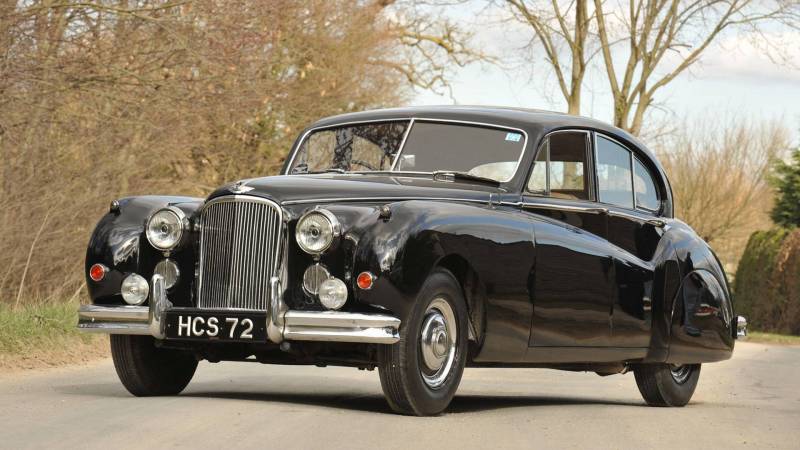Jaguar Mark VII
Production: 1950 - 1956
Production Type: Mass Production
Produced: 30969

About Jaguar Mark VII
The model continues the development of the Mk series of cars. The previous model in the series was the Jaguar Mark V, which immediately raises the question about the absence of a model with the number VI. Initially, the Mk V with an XK engine was designated as the Jaguar Mk VI, but it is believed that only two examples were built (chassis 620004 and 623053). The Mark V was originally presented as a transitional model, so the development of a new model did not stop, which allowed by 1950 the creation of a completely new "high-speed express" model (a term used by William Lyons). The car's body was manufactured using stamping (pressing) at the "Pressed Steel" plant in Cowley, and the chassis was taken from the Mark V. The differences from the previous model were immediately noticeable: a more graceful and streamlined body (the side lines echoed the body of the popular Jaguar XK120, from which this element was likely taken), integrated headlights and wings, a two-section windshield, a longer rear section, and a new type of hood ornament. The model was announced on October 22, 1950, at the "Earl's Court Motor Show." The Jaguar Mk VII was available in the classic Saloon body style, although a few examples with Drop Head Coupe bodies were made. Unfortunately, they lacked torsional rigidity, which is why the model never went into production.
Jaguar Mark VII Overview
The production of the model was completed in July-August 1954, when it was replaced by a more powerful version with a partially modified body – the Jaguar Mk VII M. A total of 20,937 Jaguar Mark VII cars were built, of which 12,754 had right-hand drive, and 8,183 had left-hand drive.
Jaguar Mark VII Technical Specification
Engine: 3442 c.c. (160 b.h.p., 5000 r.p.m) with six cylinders and two overhead camshafts, cylinder bore – 83 mm, stroke – 106 mm, seven-bearing crankshaft, compression ratio – 7 or 8:1, aluminum cylinder head with hemispherical combustion chambers, light alloy connecting rods, cast iron engine block, electric throttle with two S.U. carburetors, aluminum pistons, lubrication system: submerged pump and filter.
Transmission: 10-inch Borg & Beck clutch disc. Spiral, four-speed with synchronization. Gear ratios for manual transmission: 1st – 14.4, 2nd – 8.56, 3rd – 5.84, top – 4.27. Gear ratios for automatic transmission: 1st – 15.35, 2nd – 9.015, 3rd – 6.222, top – 4.55, overdrive – 3.538.
Frame: Strong steel frame with good stability on turns.
Suspension: Independent front suspension with transverse arm and torsion bar on hydraulic shock absorbers. Rear suspension with hydraulic shock absorbers and transverse leaf springs made of silicon manganese steel.
Brakes: Girling Dewandre – with vacuum booster and automatic adjustment. 12-inch drum brakes. Friction area: 202 1/2 square inches. Handbrake between the front seats.
Steering: Burman – screw and ball nut with an 18-inch steering wheel. Left/right-hand drive – optional.
Wheels and tires: Stamped steel wheels with Dunlop 6.70×16 Super-Comfort low-pressure tires. Spare wheel in the trunk.
Dashboard: Tachometer, 120 m.p.h. speedometer, oil gauge, ammeter, turn signal lights, electric clock, engine coolant temperature gauge.
Fuel system: Two electric S.U. pumps, two fuel tanks with 9 and 8 gallons respectively, engine fuel switch on the dashboard.
Electrical equipment: 64-amp Lucas battery, 12 volts (10-hour charge), voltage control system, air conditioning and heating system, wing lights, brake lights, ignition timing system with centrifugal regulator, instrument panel lighting in automatic and manual modes, cigarette lighter, starter, headlights, reversing light, two rear lights, dual horn, two windshield wipers.
Body and interior: Fully steel five-seater body (six-seater optional) with an opening roof, four doors, special child safety locks on the rear doors, high-quality Vaumol leather upholstery, polished walnut dashboard and wood trims, two lockable glove compartments, three ashtrays, soft armrests, felt backing with soft pile carpets. Spacious trunk at the rear with 17 cubic feet of space.
Tools: Set of hand tools and spare parts in a special compartment in the front door. Jacking: Special sockets ensure easy and convenient jacking of the car.
Paintwork: Body/Upholstery: Two-tone gray/Biscuit; Lavender Gray/Blue; Suede Green/Suede Green; Pastel Green/Gray; Pastel Blue/Blue; Ivory/Red; Black/Red; Pastel Green/Suede Green; Two-tone gray/Light Brown; Ivory/Blue; Birch/Red; Birch/Gray; Lavender Gray/Red; Black/Dark Beige; Birch/Blue; Black/Biscuit; Sea Gray/Red; Sea Gray/Gray; Sea Gray/Biscuit; Gunmetal Gray/Gray; Gunmetal Gray/Blue; Lavender Gray/Suede Green; Gunmetal Gray/Red; Black/Light Brown; Black/Gray; Twilight Blue/Blue.
Dimensions: Overall length – approximately 16′ 4 1/2″, width – 6′ 1″, height – 5′ 3″, ground clearance – 7 1/2″. Wheelbase – 10′ 0″, front track width – 4′ 8″, rear track width – 4′ 9 1/2″. Turning circle – 36′ 0″. Weight – 33 cwt.
Price: In 1950 – £1693.